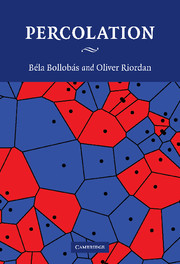Book contents
- Frontmatter
- Contents
- Preface
- 1 Basic concepts and results
- 2 Probabilistic tools
- 3 Bond percolation on ℤ2 – the Harris–Kesten Theorem
- 4 Exponential decay and critical probabilities – theorems of Menshikov and Aizenman & Barsky
- 5 Uniqueness of the infinite open cluster and critical probabilities
- 6 Estimating critical probabilities
- 7 Conformal invariance – Smirnov's Theorem
- 8 Continuum percolation
- Bibliography
- Index
- List of notation
8 - Continuum percolation
Published online by Cambridge University Press: 05 June 2012
- Frontmatter
- Contents
- Preface
- 1 Basic concepts and results
- 2 Probabilistic tools
- 3 Bond percolation on ℤ2 – the Harris–Kesten Theorem
- 4 Exponential decay and critical probabilities – theorems of Menshikov and Aizenman & Barsky
- 5 Uniqueness of the infinite open cluster and critical probabilities
- 6 Estimating critical probabilities
- 7 Conformal invariance – Smirnov's Theorem
- 8 Continuum percolation
- Bibliography
- Index
- List of notation
Summary
Shortly after Broadbent and Hammersley started percolation theory and Erdős and Rényi [1960; 1961a], together with Gilbert [1959], founded the theory of random graphs, Gilbert [1961] started a closely related area that is now known as continuum percolation. The basic objects of study are random geometric graphs, both finite and infinite. Such graphs model, for example, a network of transceivers scattered at random in the plane or a planar domain, each of which can communicate with those others within a fixed distance.
Although this field has attracted considerably less attention than percolation theory, its importance is undeniable; in this single chapter, we cannot do justice to these topics. Indeed, this area has been treated in hundreds of papers and several monographs, including Hall [1988] on coverage processes, Møller [1994] on random Voronoi tessellations, Meester and Roy [1996] on continuum percolation, and Penrose [2003] on random geometric graphs. These topics are also touched upon in the books by Matheron [1975], Santaló [1976], Stoyan, Kendall and Mecke [1987; 1995], Ambartzumian [1990] and Molchanov [2005].
In the first section we present the most basic model of continuum percolation, the Gilbert disc model or Boolean model, and give some fundamental results on it, including bounds on the critical area. In the second section we take a brief look at finite random geometric graphs, with emphasis on their connectedness. The most important part of the chapter is the third section, in which we shall sketch a proof of the analogue of the Harris–Kesten result for continuum percolation: the critical probability for random Voronoi percolation in the plane is 1/2.
- Type
- Chapter
- Information
- Percolation , pp. 240 - 298Publisher: Cambridge University PressPrint publication year: 2006



